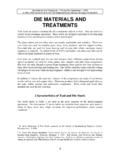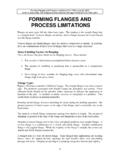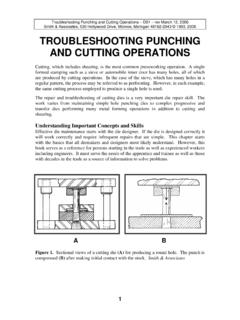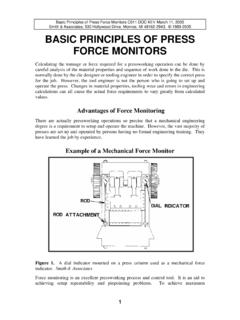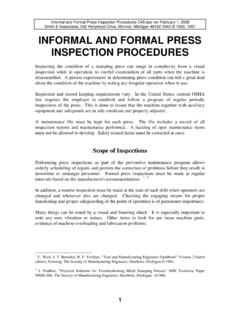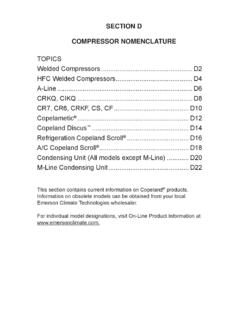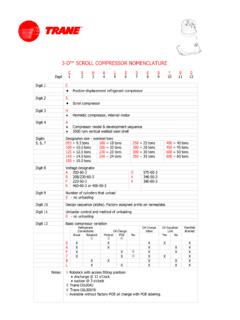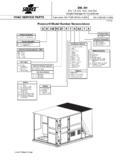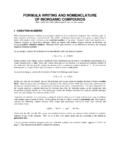Transcription of Mechanical Press Types & Nomenclature
1 Mechanical Press Types and Nomenclature 1993-2005 David Alkire Smith, 530 Hollywood Drive, Monroe, Michigan 48162-2943 Rev August 19, 2005. Mechanical Press Types . AND Nomenclature . A Mechanical power Press is a machine used to supply force to a die that is used to blank, form, or shape metal or nonmetallic material. Thus, a Press is a component of a manufacturing system that combines the Press , a die, material and feeding method to produce a part. The designer of the manufacturing system must also provide proper point of operation guards to safeguard pressroom personnel. Each of the components of this manufacturing system is important and will be discussed in turn later in this work. A. foundation for understanding the system is acquiring a working knowledge of the Press . Types OF PRESSES. There are over 300,000 presses in use in the United States and many more worldwide.
2 Mechanical presses fall into two predominant Press Types : gap frame and straight side Types . The frame Types used in Mechanical presses are similar to those used in many hydraulic presses. Here, we will limit our discussion to Mechanical presses. The drive systems, clutches, brakes, counterbalance systems, die cushions, electrical, hydraulic and pneumatic features are similar in both the gap frame and straight side Types . The type and size of Press selected is mainly determined by the work to be done. Gap Frame Presses Figure 1 illustrates one type of gap frame Press . The principle feature of gap frame machines is the C-shaped opening. For this reason, gap frame presses are also referred to as C-frame presses. In Press force capacities up to approximately 250 tons (2,224 kn.) and larger, gap frame presses are less costly than a straightside Press having the same force capacity and control features.
3 In the 35 to 60-ton (311 to 534 kN) force range, they may cost approximately half as much as straightside Press . The C-shaped throat opening has the advantage of permitting access to the die from three sides. This enables pressworking operations to be carried out on the corners and sides of large sheets of material. The open back is also accessible for discharging finished parts and scrap as well as feeding stock. The open accessibility from three sides facilitates quick die change with simple equipment. The ease of access is also useful for trying out and repairing dies in the Press . 1. Mechanical Press Types and Nomenclature 1993-2005 David Alkire Smith, 530 Hollywood Drive, Monroe, Michigan 48162-2943 Rev August 19, 2005. Open Back Inclinable (OBI) Gap Frame Press Figure 1. A typical gap frame open back inclinable (OBI) Mechanical Press .
4 Verson Corporation The main disadvantage of gap frame presses is that there is an unavoidable angular misalignment that occurs under load. Limiting the amount of angular misalignment requires very robust construction, which adds to the weight and cost of the machine. Straightside Presses Straightside presses derive their name from the vertical columns or uprights on either side of the machine. The columns together with the bed and crown form a strong housing for the crankshaft, slide and other Mechanical components. The housing or frame of most straightside presses is held together in compression by pre- stressed tie rods. Some straightside presses have solid frames. Generally a solid frame straightside Press is less expensive than one having tie rods. However, tie rod presses are easier to ship disassembled and have better ability to withstand overloads.
5 2. Mechanical Press Types and Nomenclature 1993-2005 David Alkire Smith, 530 Hollywood Drive, Monroe, Michigan 48162-2943 Rev August 19, 2005. Freedom from angular deflection under load is one reason for choosing a straightside rather than gap frame Press for work involving close tolerance dies. The part dimensional accuracy and number of hits between necessary die maintenance often improves by a factor of three or more. Basic Straight Side Mechanical Press Nomenclature Figure 2. A straightside Mechanical Press having double end drive gears and two connections. Smith & Associates Straightside Press Constriction Figure 2 illustrates some of the principle Mechanical components of a straightside Press having double end drive gears and two connections. The bed is the base of the machine. The columns support the crown, and have gibs attached which guide the slide.
6 The crankshaft end bearings may be contained in the columns or crown. The crown serves many functions depending upon machine design. Typically, the clutch, brake, motor and flywheel mount on the crown of the Press . The gears shown in Figure 2. may be open having only a safety guard designed to contain the gear in the event that it should fall off due to a failure such as a broken crankshaft. 3. Mechanical Press Types and Nomenclature 1993-2005 David Alkire Smith, 530 Hollywood Drive, Monroe, Michigan 48162-2943 Rev August 19, 2005. In modern designs, the gears are fully enclosed and run in a bath of lubricant. Enclosing the gears in separate enclosures from the rest of the machine permits using a heavier viscosity lubricant than that used for other machine parts such as the bearings. The latter are often supplied from a recirculating lubricant system.
7 The separate gear housing and lubricant bath system serves to lessen noise and insure long gear life. The tie rods hold the housing assembly in compression. The pitman, connection, bolster and other parts have similar functions in both gap frame and straightside presses. Types of Mechanical Press Drives In nongeared or direct drive presses as they are also known, the flywheel is mounted on the end of the crankshaft. The flywheel is motor driven by means of a belt drive. Directly driven presses are capable of much higher operating speeds than geared Types . Speeds range from under 100 strokes per minute to over 1,800 for short stroke high-speed operation. 1. Figure 3. A nongeared drive illustrating a double-throw crankshaft directly driven by the flywheel through a frictional clutch. Energy is transferred from the motor to the flywheel by several V-belts.
8 Direct Drive Mechanical Press Applications Nongeared presses find widespread application in blanking, high-speed production and shallow forming operations. They have several major advantages over all other Press Types . First, the design is simple. There are few bearings and no gears to wear out. In addition, frictional losses are lower than that of Mechanical geared and hydraulic presses. 1. N. Fisher. Principles of Mechanical Power Presses , SME Technical Paper MS76-285, The Society of Manufacturing Engineers, Dearborn, Michigan, 1976. The author, N. Fisher, updates the material for public presentations. 4. Mechanical Press Types and Nomenclature 1993-2005 David Alkire Smith, 530 Hollywood Drive, Monroe, Michigan 48162-2943 Rev August 19, 2005. Example of a Direct Drive Press Figure 4. An example of a direct drive straightside Press showing the flywheel and clutch in a metal enclosure.
9 Note the Eaton variable speed drive motor mounted on top of the machine. The high operating speeds provide much greater productivity than that of geared presses. The direct drive Press is very popular for precision progressive die and high speed perforating operations. Two main factors limit the application of the direct driven Press . First, the full rated force of the machine is only available very close to the bottom of the stroke; typically ( mm) from bottom dead center. A second disadvantage is that the ability to deliver rated forces is substantially reduced if the Press is operated at less than full speed. The nongeared Press illustrated in Figure 4, built by the Minster Machine Company has been in service for approximately 25 years. It is equipped with an Eaton variable speed drive adjustable up to 300 strokes per minute.
10 The machine still meets original specifications for alignment and bearing clearances when regularly inspected. A. combination of good basic design and careful maintenance make long trouble free service life possible. Single Gear Reduction Presses In single gear reduction presses, the flywheel is mounted on the backshaft and the power is then transmitted through a pinion to a main gear mounted on the crankshaft. Some single gear reduction presses have main gears mounted on both ends of the crankshaft, which is mounted on a pinion double end gear presses. Single gear reduction presses typically operate in the speed range of 16 to 200 strokes per minute (SPM). 5. Mechanical Press Types and Nomenclature 1993-2005 David Alkire Smith, 530 Hollywood Drive, Monroe, Michigan 48162-2943 Rev August 19, 2005.
